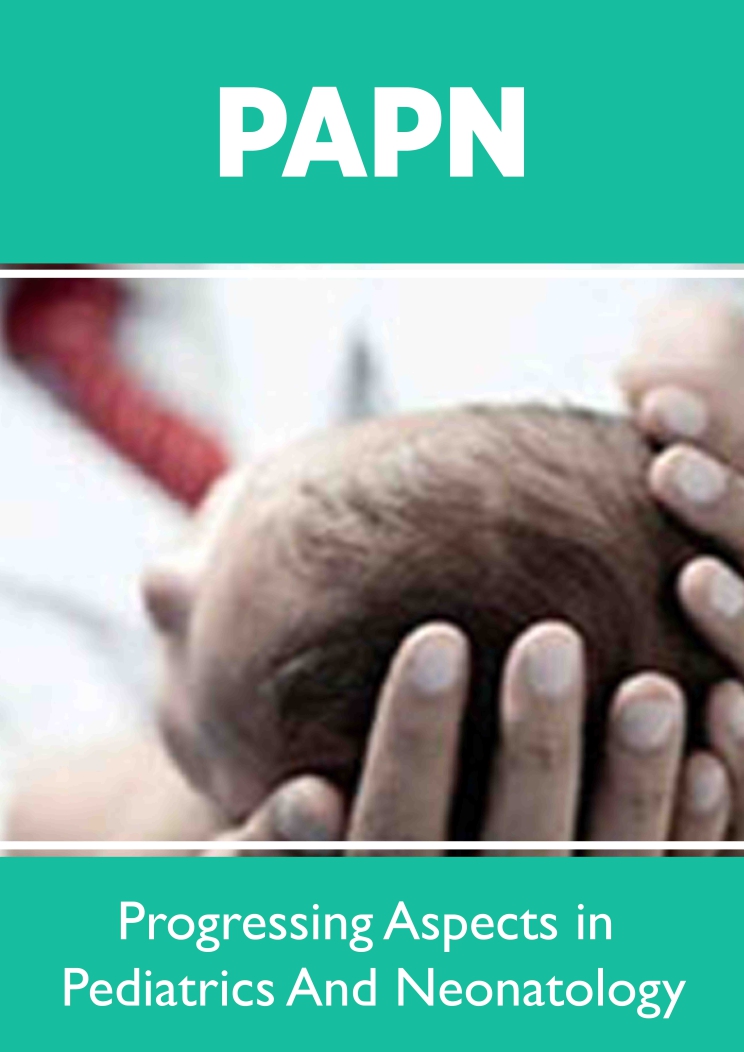
Lupine Publishers Group
Lupine Publishers
Menu
ISSN: 2637-4722
Case Report(ISSN: 2637-4722) 
Newborn With 21 Trysomy and Chilous pleural Effusion Volume 1 - Issue 4
Khatuna Lomauri*
- Department of Neonatal Intensive Care Unit, Tbilisi State Medical University, Georgia, UK
Received: July 02, 2018; Published: July 13, 2018
*Corresponding author: Khatuna Lomauri, Department of Neonatal Intensive Care Unit, Tbilisi State Medical University, Georgia, UK
DOI: 10.32474/PAPN.2018.01.000120
Abstract
Neonatal chylothorax results from the accumulation of chyle in the pleural space and may be either congenital or an acquired condition. Congenital chylothorax is most likely due to abnormal development or obstruction of the lymphatic system and often associated with hydropsfetalis. It can be idiopathic or may be associated with various chromosomal and other genetic abnormalities. It is important to identify infants with chylothorax, as there are specific issues that need to be addressed in the management of these patients. In the neonate, chylous effusion is a common cause of pleural effusions and characterized as an exudate because of the high protein and lipid content once the infant is fed. The fluid will be clear/yellow to slightly cloudy in the unfed state and will quickly become milky following feeding, as chylomicrons appear in the fluid. Lymphocytes predominate in the differential cell count of chyle. The volume of fluid output can be high, and management can be challenging.
We present a case of newborn with 21 trisomy who developed moderate RDS, chest X-ray and US reveal pleural effusion on right side, rapid intervention was made before deterioration, requiring intensive life-saving measures. We review the common manifestations of congenital chylotoraxes and emphasize the importance of early diagnosis and intervention in preventing devastating outcomes from this condition.
Keywords: Chylothorax; Pleural Effusion; Respiratory Distress Syndrome (RDS); Positive Pressure Ventilation (PPV)
Case Presentation
Prenatal and Birth Histories
Mom was a 35yo G2P2 who came into L&D at 37+5/7wks in active labor. She did not receive antenatal steroids or antibiotics. Serology: A+, RPR neg, Hep B neg, HIV neg, GBS status - unknown. It was spontaneous vaginal delivery of a male infant with trisomy 21, which was diagnosed antenatally. The pediatric team was called to a “code blue” for fetusbradycardia. At delivery, the infant had a HR>100/min, but no respiratory effort, and was limp and blue. He required PPV (& Oxygen) with Ambu Bag and color/tone improved. Apgar Scores were 2 and 7 at 1 and 5minutes, respectively. BW was 2800grams.
Physical Examination at Birth
a) Head: Flat occiput; up-slanting palpebral fissures; bilateral epicanthal folds; flat nasal bridge; hypertelorism;
b) Oral Cavity: Moist pink mucosae; intact palate; normal sucking and rooting reflex;
c) Lungs: Moderate respiratory distress, auscultation breath sounds not equal bilaterally; especially less on the right side;
d) Cardiovascular: First and second heart sounds heard; regular rate and rhythm; grade 3/6 murmur noted over left sternal border;
e) Abdomen: Not distended; soft; no organomegaly; not tender; umbilicus clean with 3 vessels;
f) Genitourinary: Normal male genitalia, patent anus;
g) Skeletal: Normal Semian line on hands, wide gap between 1-st and 2-nd toes on feet;
h) Skin: no rash or birthmarks.
Clinical Condition
Within First 2hrs
Respiratory status: dyspnea, SpO2 -92%, with FiO2 45%; Echo: mild to moderate VSD and a PDA; X-ray and Chest Ultrasound: pleural effusion on right side; Abdominal US: with no pathology; Normal micturition and defecation. Lab studies: CBC - lymphocitopenia, CRP - 16mg/dl; Capillary blood gas: 7.25/65/28/+1 - respiratory acidosis; Thoracocentesis was performed, with approximately 60mL fluid obtained for culture and diagnostic studies; blood culture was obtained, amp/gen was given;
After 8hrs
Respiratory status remains unchanged: tachypnea, mild sternal retraction. X-ray: with no improvement; Chest US: effusion on right pleural space, covering almost all right lung; Chest tube was inserted; CT scan: no malignancy in mediastinum;
Pleural Fluid Analysis
On Fasting
Clear slight cloudy; pH: 7.45; White blood cell count: 3000/μL (3.00 × 109/L); Red blood cell count: 39/μL (0.039 × 109/L); Lymphocytes: 90% (0.90); Triglycerides: 1,120mg/dL (12,5mmol/L); Cholesterol: 70mg/dL (1.8mmol/L) ;Monocytes: 4% (0.4); Glucose: 49mg/dL (2,7mmol/L); Protein: 2,8g/dL (28g/L); Albumin: 2.2g/dL (22g/l).
After Giving LCT Formula
Milky Yellow Turbid Fluid; pH: 7.52; White blood cell count: 3250/μL (3.25 × 109/L); Red blood cell count: 33/μL (0.033 × 109/L); Lymphocytes: 96% (0.96); Triglycerides: 1,500mg/dL (16.95mmol/L); Cholesterol: 72mg/dL (1.9mmol/L); Monocytes: 4% (0.4); Glucose: 89mg/dL (4.9mmol/L); Protein: 3.2g/dL (32g/L); Albumin: 2.6g/dL (26g/l);
Management
a) Pleural drainage and measument of chyle flow were done;
b) NPO and nutritional support with TPN;
c) TPN was weaned off 5 days after the introduction of MCT formula; No breast Milk!
The infant was discharged home on day 36 with instructions to continue taking the medium chain triglyceride-based formula until re-evaluation follows up [1,2] (Figure 1).
Conclusion
Congenital Chylothorax is a rare condition with multiple etiologies. Pleural fluid analysis can identify this condition when clinical suspicion exists. Conservative management is generally recommended in most cases with surgery being reserved for those that have a large or persistent leak or in those who become immunologically challenged or malnourished.
References

Top Editors
-

Mark E Smith
Bio chemistry
University of Texas Medical Branch, USA -

Lawrence A Presley
Department of Criminal Justice
Liberty University, USA -

Thomas W Miller
Department of Psychiatry
University of Kentucky, USA -

Gjumrakch Aliev
Department of Medicine
Gally International Biomedical Research & Consulting LLC, USA -

Christopher Bryant
Department of Urbanisation and Agricultural
Montreal university, USA -

Robert William Frare
Oral & Maxillofacial Pathology
New York University, USA -

Rudolph Modesto Navari
Gastroenterology and Hepatology
University of Alabama, UK -

Andrew Hague
Department of Medicine
Universities of Bradford, UK -

George Gregory Buttigieg
Maltese College of Obstetrics and Gynaecology, Europe -

Chen-Hsiung Yeh
Oncology
Circulogene Theranostics, England -
.png)
Emilio Bucio-Carrillo
Radiation Chemistry
National University of Mexico, USA -
.jpg)
Casey J Grenier
Analytical Chemistry
Wentworth Institute of Technology, USA -
Hany Atalah
Minimally Invasive Surgery
Mercer University school of Medicine, USA -

Abu-Hussein Muhamad
Pediatric Dentistry
University of Athens , Greece

The annual scholar awards from Lupine Publishers honor a selected number Read More...















